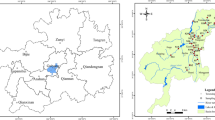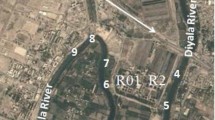Abstract
Beidagang Wetland (BW) Nature Reserve is centrally situated in Tianjin City, experiencing an extreme industrial development. This study uses index characteristic analysis systems for assessing the individual and combined heavy metal pollution loading in the water during the spring and autumn seasons. By combining the pollution level of single pollutant, a more comprehensive evaluation of water quality in BW was achieved. Water quality was worst during autumn due to high level of Cd and Pb, which indicate the type of anthropogenic activities have a serious effect on heavy metal pollution in BW. In addition, high exchangeable amounts of Cd (> 40%) were found in the sediments of BW, indicating Cd pollution has emerged. There is a need for appropriate abatement actions curbing heavy metal loading and improving water quality of the BW Nature Reserve, thereby ensuring a sustainable management of its ecosystem services.





Similar content being viewed by others
References
Abrahim GMS, Parker RJ (2008) Assessment of heavy metal enrichment factors and the degree of contamination in marine sediments from Tamaki Estuary, Auckland, New Zealand. Environ Monit Assess 136:227–238
Chen Y, Song Q, Pan L, Jia M, Li C, Hu B, Wu G (2018) Trace metals, organic carbon and nutrients in the Beidagang Wetland Nature Reserve, northern China. PLoS ONE 13:e0204812
Covelli S, Fontolan G (1997) Application of a normalization procedure in determining regional geochemical baselines. Environ Geol 30:34–45
Cresswell T, Smith REW, Nugegoda D, Simpson SL (2013) Challenges with tracing the fate and speciation of mine-derived metals in turbid river systems: implications for bioavailability. Environ Sci Pollut Res 20:7803–7814
Desaules A (2012) Critical evaluation of soil contamination assessment methods for trace metals. Sci Total Environ 426:120–131
Fang T, Yang K, Lu WX, Cui K, Li J, Liang YY, Hou GJ, Zhao XX, Li H (2019) An overview of heavy metal pollution in Chaohu Lake, China: enrichment, distribution, speciation, and associated risk under natural and anthropogenic changes. Environ Sci Pollut Res 26:29585–29596
Filgueiras AV, Lavilla I, Bendicho C (2002) Chemical sequential extraction for metal partitioning in environmental solid samples. J Environ Monit 4:823–857
Gao XL, Chen CTA (2012) Heavy metal pollution status in surface sediments of the coastal Bohai Bay. Water Res 46:1901–1911
Garnier J-M, Garnier J, Jezequel D, Angeletti B (2015) Using DET and DGT probes (ferrihydrite and titanium dioxide) to investigate arsenic concentrations in soil porewater of an arsenic-contaminated paddy field in Bangladesh. Sci Total Environ 536:306–315
Guo WH, Liu XB, Liu ZG, Li GF (2010) Pollution and potential ecological risk evaluation of heavy metals in the sediments around Dongjiang Harbor, Tianjin. Procedia Environ Sci 2:729–736
Hakanson L (1980) An ecological risk index for aquatic pollution control: a sedimentological approach. Water Res 14:975–1001
Huo SL, Xi BD, Yu XJ, Su J, Zan FY, Zhao GC (2013) Application of equilibrium partitioning approach to derive sediment quality criteria for heavy metals in a shallow eutrophic lake, Lake Chaohu, China. Environ Earth Sci 69:2275–2285
Hwang DW, Kim PJ, Kim SG, Sun CI, Kim TH (2019) Spatial distribution and pollution assessment of metals in intertidal sediments, Korea. Environ Sci Pollut Res 26:19379–19338
Islam MS, Ahmed MK, Raknuzzaman M, Habibullah-Al-Mamun M, Islam MK (2015) Heavy metal pollution in surface water and sediment: a preliminary assessment of an urban river in a developing country. Ecol Ind 48:282–291
Jonge MD, Teuchies J, Meire P, Blust R, Bervoets L (2012a) The impact of increased oxygen conditions on metal-contaminated sediments part I: effects on redox status, sediment geochemistry and metal bioavailability. Water Res 46:3387–3397
Jonge MD, Teuchies J, Meire P, Blust R, Bervoets L (2012b) The impact of increased oxygen conditions on metal-contaminated sediments part II: effects on metal accumulation and toxicity in aquatic invertebrates. Water Res 46:2205–2214
Larner BL, Seen AJ, Townsend AT (2006) Comparative study of optimised BCR sequential extraction scheme and acid leaching of elements in the certified reference material NIST 2711. Anal Chim Acta 556:444–449
Li H, Lei P, Li X, Liu HL, Zhou B, Chen C, Xing MN, Li XX, Kong WL (2021) Distribution characteristics and pollution assessment of nitrogen and phosphorus in sediments from Beidagang Wetland in Tianjin City. Acta Sci Circum 41:4086–4096
Nobi EP, Dilipan E, Thangaradjou T, Sivakumar K, Kannan L (2010) Geochemical and geo-statistical assessment of heavy metal concentration in the sediments of different coastal ecosystems of Andaman Islands, India. Estuar Coast Shelf Sci 87:253–264
Nolan AL, Zhang H, McLaughlin MJ (2005) Prediction of zinc, cadmium, lead, and copper availability to wheat in contaminated soils using chemical speciation, diffusive gradients in thin films, extraction, and isotopic dilution techniques. J Environ Qual 34:496–507
Pavageau MP, Pecheyran C, Krupp EM, Morin A, Donard OFX (2002) Volatile metal species in coal combustion flue gas. Environ Sci Technol 36:1561–1573
Perez AL, Anderson KA (2009) DGT estimates cadmium accumulation in wheat and potato from phosphate fertilizer applications. Sci Total Environ 407:5096–5103
Pueyo M, Mateu J, Rigol A, Vidal M, Lopez-Sanchez JF, Rauret G (2008) Use of the modified BCR three-step sequential extraction procedure for the study of trace element dynamics in contaminated soils. Environ Pollut 152:330–341
Rauret G, Lopez-Sanchez JF, Sahuquillo A, Rubio R, Davidson C, Ure A, Quevauviller Ph (1999) Improvement of the BCR three step sequential extraction procedure prior to the certification of new sediment and soil reference materials. J Environ Monit 1:57–61
Song ZX, Song GF, Tang WZ, Yan DD, Shan BQ (2020) Determining cadmium bioavailability in sediment profiles using diffusive gradients in thin films. J Environ Sci 91:160–167
Tang WZ, Zhao Y, Wang C, Shan BQ, Cui JG (2013) Heavy metal contamination of overlying waters and bed sediments of Haihe Basin in China. Ecotoxicol Environ Saf 98:317–323
Tang WZ, Pei YS, Zheng H, Zhao Y, Shu LM, Zhang H (2022) Twenty years of China’s water pollution control: Experiences and challenges. Chemosphere 295:133875
Wang SJ, Ma HT, Zhao YB (2014) Exploring the relationship between urbanization and the eco-environment—a case study of Beijing–Tianjin–Hebei region. Ecol Ind 45:171–183
Wang NL, Wang JM, Li YY, Xing MN, Zhou B, Li X, Li XX, Kong WL, Ding LX, Liu HL (2020) Occurrences, retention and risk assessments of PAHs in Beidagang Wetland in Tianjin, China. Bull Environ Contam Toxicol 105:607–612
Xie Z, Liu J, Zhu G, Shao Q, Xu X (2011) Evaluating habitat change and boundary adjustment of a nature reserve in coastal wetlands: case study of Beidagang Nature Reserve, China. J Coastal Res 27:966–972
Zhang C, Yu ZG, Zeng GM, Jiang M, Yang ZZ, Cui F, Zhu MY, Shen LQ, Hu L (2014) Effects of sediment geochemical properties on heavy metal bioavailability. Environ Int 73:270–281
Zhang X, Zhong T, Liu L, Ouyang X (2015) Impact of soil heavy metal pollution on food safety in China. PLoS ONE 10:e0135182
Acknowledgements
This research was supported by Tianjin Science and technology project (Grant No.18ZXSZSF00130).
Funding
Funding was provided by Tianjin Science and Technology Committee (Grant No. 18ZXSZSF00130).
Author information
Authors and Affiliations
Corresponding author
Additional information
Publisher's Note
Springer Nature remains neutral with regard to jurisdictional claims in published maps and institutional affiliations.
Supplementary Information
Below is the link to the electronic supplementary material.
Rights and permissions
About this article
Cite this article
Zhou, B., Xing, M., Liao, H. et al. Assessing Heavy Metal Pollution of the Largest Nature Reserve in Tianjin City, China. Bull Environ Contam Toxicol 109, 684–690 (2022). https://doi.org/10.1007/s00128-022-03545-z
Received:
Accepted:
Published:
Issue Date:
DOI: https://doi.org/10.1007/s00128-022-03545-z




